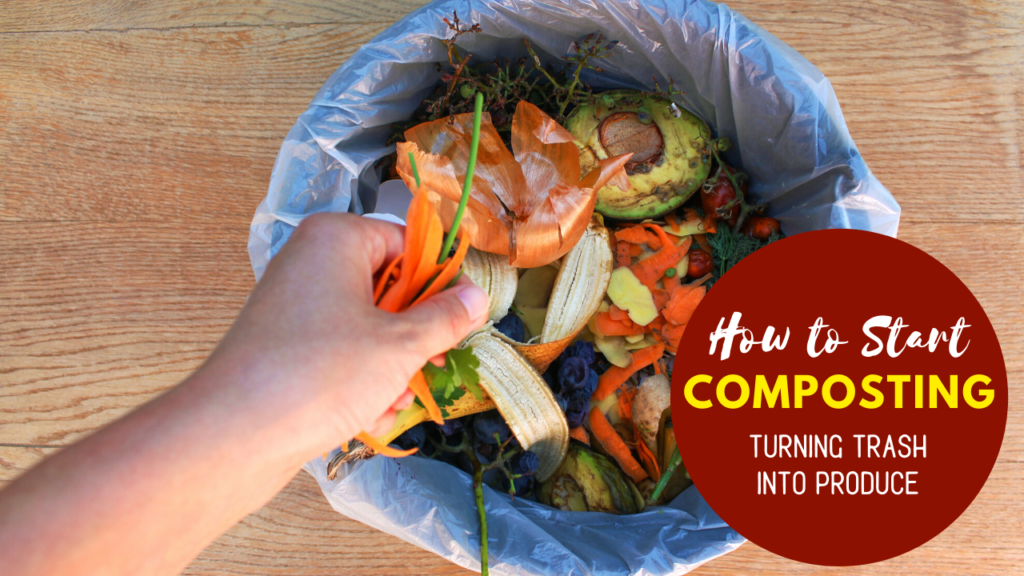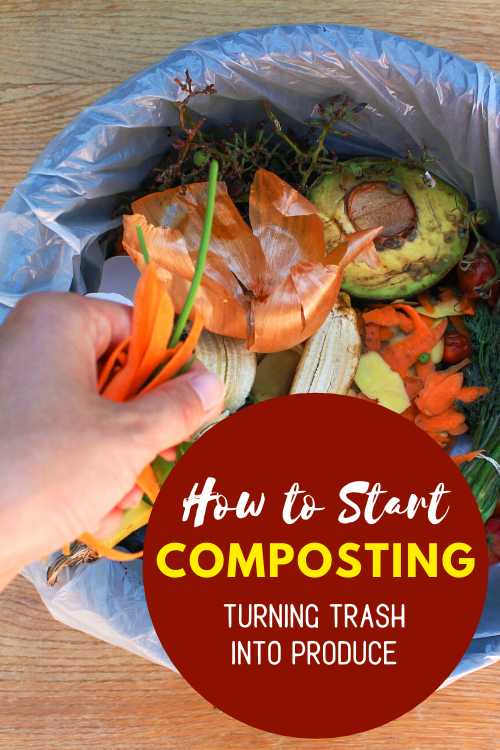This post may contain affiliate links. Read our disclosure here.

Many people are focused on starting a vegetable garden at this time of year, but one thing you shouldn’t forget is how easy it is for you to create your own soil that is nutrient-rich and perfect for growing awesome vegetables. Think of this as a way of turning your trash into treasures! I’m going to share all the information you need on how to start composting so you can turn your garbage and kitchen scraps into new produce.
How to Start Composting: Turning Trash into New Produce
What can you compost?
You are going to be surprised here, but most trash folks would say that your house is filled with things that can be recycled or composted. The list of what you can compost is very long, so to make it easier I’m going to go by categories.
Note: Chop, shred, or break anything you put into the compost in smaller pieces to speed up composting time.
Coffee grounds (and filters)
Tea (with or without bag)
Fruit & veggie peels, seeds and other unused portions
Egg shells (crush into tinier pieces first)
Flowers
Cardboard and paper
Dryer lint
Grass clippings
A few things to NOT compost:
Meat products, fat, grease or bones (slow to degrade and attracts animals)
Fireplace ashes (can contain materials that end up killing future plants)
Used cat litter (can contain micro-organisms that will be harmful in food items)
What container should you use indoors?
I’m serious when I say all you need is a bowl. Pick a bowl that you are cool with living on your counter all the time. If you are like me and don’t always remember to empty your compost bowl everyday then you can “splurge” and get a composting bucket.

We have one of these and the filter in the top of the bucket works wonderfully to where I’ll forget to empty it for days. A bowl works just fine, though, if you assign a kid the task of emptying it daily.
What container should you use outdoors?

The jury is out on whether you should have open air or closed box composting systems. Some cities will only allow closed systems, so find out what you can have before making a plan. In general, the closed system is meant to do two things: keep pests (animals) out and speed up composting time by keeping it hotter. They aren’t the most user friendly when you are ready to use the soil, but they do get the job done.
For low out-of-pocket costs, go with an open air system. Build a small box like a raised flower bed that is at least 3ft x 3ft. You can even use old pallets for it and spend nothing. You can get old pallets on Craigslist or from businesses.

Once you have your box, open or closed, now it’s time to start actually building soil. To aid composting, your box needs to have four things:
1. A mix of things in it (not just grass clippings).
2. Heat
3. Water
4. Rotation
Make sure that you are composting a wide range of materials. This increases the speed at which the items will breakdown. If all you put in are grass clippings, then it has nothing to help break it down, compared to if you add in fruits, veggies, etc.
The heat and water are the part that you can help control. You want damp compost but not soggy compost, so if your bin is a closed unit, don’t leave the top off in a giant rain storm. If you have an open air bin and it’s a dry and hot summer, then add leftover beverages and even dirty kitchen water to your compost bucket each day.
Rotation is the only part of this that requires actual work. At least two times a week, you need to go out and turn your compost. Closed systems will need to be rolled, and in an open air system, you will take a pitchfork or shovel and turn the pile by hand. Again, both work just fine.
Once you get started, this will become a normal part of your routine. You’ll also find that your kids find this very fun and love to see the process from beginning to end.
After a few months, you’ll be able to start using the compost in your garden. Then, as you grow vegetables in your garden, you’ll automatically be creating more stuff to put in your compost—it’s a perfect cycle!
Another way to use your yard to save money is to raise backyard chickens!




